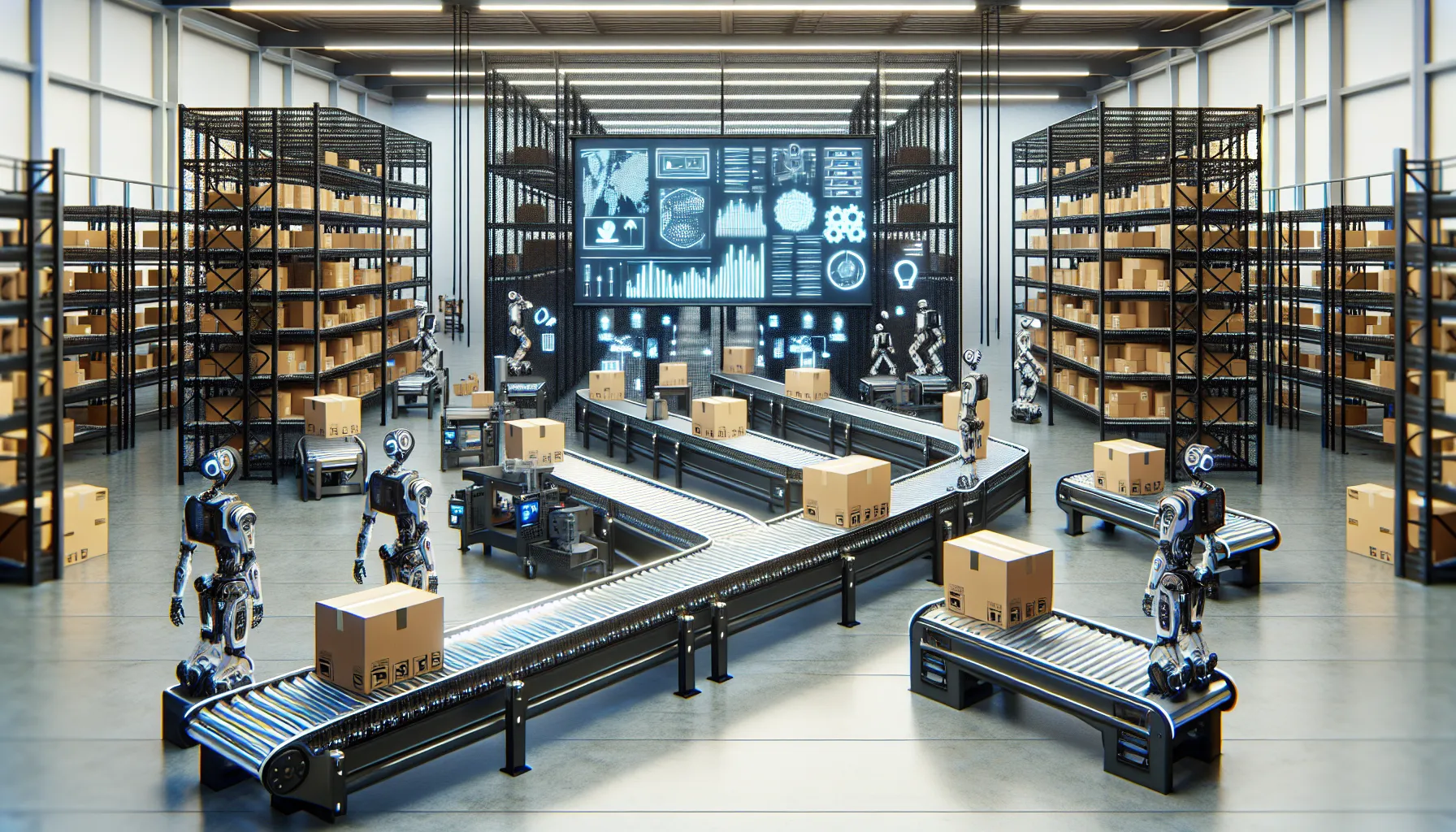Are you preparing for the IELTS Reading test and looking to enhance your skills on topics related to technology and business? This practice test focuses on the impact of automation on retail supply chains, a crucial subject in today’s rapidly evolving retail landscape. Let’s dive into three passages of increasing difficulty, followed by a variety of question types to test your comprehension and analytical skills.
Nội dung bài viết
- Passage 1 – Easy Text
- The Rise of Automation in Retail Supply Chains
- Questions 1-5
- Questions 6-10
- Passage 2 – Medium Text
- The Transformation of Retail Supply Chains through Automation
- Questions 11-14
- Questions 15-20
- Passage 3 – Hard Text
- The Intricate Web of Automation in Retail Supply Chains: Challenges, Innovations, and Future Prospects
- Questions 21-26
- Questions 27-32
- Questions 33-36
- Answer Key
- Passage 1:
- Passage 2:
- Passage 3:
Passage 1 – Easy Text
The Rise of Automation in Retail Supply Chains
In recent years, the retail industry has undergone a significant transformation, largely due to the integration of automation technologies into supply chain operations. This shift has been driven by the need for increased efficiency, cost reduction, and improved customer satisfaction. Automation in retail supply chains encompasses a wide range of technologies, from robotics in warehouses to artificial intelligence in inventory management.
One of the primary areas where automation has made a substantial impact is in warehouse operations. Automated guided vehicles (AGVs) and robotic arms are now commonplace in many distribution centers, handling tasks such as picking, packing, and sorting with greater speed and accuracy than their human counterparts. These technologies not only increase productivity but also reduce the likelihood of errors and workplace injuries.
Another crucial aspect of supply chain automation is the use of data analytics and machine learning algorithms to optimize inventory management. These systems can predict demand patterns, automate reordering processes, and ensure that the right products are available at the right time and place. This level of precision helps retailers minimize stockouts and overstock situations, leading to improved customer satisfaction and reduced operational costs.
The implementation of automation in retail supply chains has also led to significant improvements in last-mile delivery. Autonomous vehicles and drones are being tested for package delivery in urban areas, promising faster and more flexible delivery options for consumers. Additionally, automated sorting systems in distribution centers enable retailers to process orders more quickly and accurately, reducing delivery times and enhancing the overall customer experience.
While the benefits of automation in retail supply chains are evident, it’s important to note that the transition is not without challenges. Initial investment costs can be substantial, and there are concerns about job displacement for workers in traditional supply chain roles. However, many industry experts argue that automation will create new job opportunities in areas such as technology maintenance, data analysis, and customer service.
As we look to the future, it’s clear that automation will continue to play a pivotal role in shaping the retail supply chain landscape. Retailers who embrace these technologies are likely to gain a competitive edge in an increasingly digital marketplace, offering improved efficiency, accuracy, and customer satisfaction.
 Automated retail supply chain
Automated retail supply chain
Questions 1-5
Do the following statements agree with the information given in the reading passage?
Write
TRUE if the statement agrees with the information
FALSE if the statement contradicts the information
NOT GIVEN if there is no information on this
- Automation in retail supply chains has led to increased efficiency and cost reduction.
- Automated guided vehicles are less accurate than human workers in warehouse operations.
- Data analytics and machine learning are used to predict customer demand patterns.
- All major retailers have fully automated their supply chain operations.
- The implementation of automation in retail supply chains has resulted in faster delivery times for customers.
Questions 6-10
Complete the sentences below.
Choose NO MORE THAN TWO WORDS from the passage for each answer.
- In warehouse operations, automation technologies such as robotics and AGVs have reduced the likelihood of __ and workplace injuries.
- Automated systems in inventory management help retailers minimize __ and overstock situations.
- __ and drones are being tested for package delivery in urban areas.
- The transition to automated supply chains involves substantial __ costs for retailers.
- Despite concerns about job displacement, experts believe automation will create new opportunities in areas such as technology maintenance and __.
Passage 2 – Medium Text
The Transformation of Retail Supply Chains through Automation
The retail industry is experiencing a paradigm shift as automation technologies reshape supply chain operations. This transformation is not merely an incremental improvement but a fundamental reimagining of how goods move from manufacturers to consumers. The impact of automation on retail supply chains is multifaceted, affecting everything from warehouse management to customer service interactions.
One of the most visible manifestations of this change is the proliferation of robotic systems in distribution centers. These advanced machines, equipped with sophisticated sensors and artificial intelligence, can navigate complex warehouse environments, locate specific items, and execute picking and packing tasks with remarkable precision. The efficiency gains are substantial, with some retailers reporting productivity increases of up to 300% in certain operations.
However, the influence of automation extends far beyond the warehouse floor. Predictive analytics and machine learning algorithms are revolutionizing demand forecasting and inventory optimization. These systems can process vast amounts of data, including historical sales figures, weather patterns, and social media trends, to generate highly accurate demand predictions. This level of foresight allows retailers to maintain optimal stock levels, reducing both excess inventory costs and the likelihood of stockouts.
The integration of automation into transportation and logistics has also been transformative. Autonomous vehicles are being piloted for long-haul trucking routes, promising increased safety and efficiency. In urban areas, last-mile delivery is being reimagined with the introduction of delivery robots and drones. These innovations not only reduce delivery times but also offer greater flexibility in terms of delivery windows and locations.
Perhaps one of the most significant impacts of automation on retail supply chains is the enhancement of visibility and traceability. Internet of Things (IoT) devices and blockchain technology are being employed to create transparent, end-to-end supply chain tracking systems. This increased visibility allows retailers to quickly identify and address issues, ensure product authenticity, and provide customers with real-time updates on their orders.
The adoption of automation technologies in retail supply chains is not without its challenges. The initial capital investment required can be substantial, and there are concerns about the potential displacement of workers in traditional supply chain roles. Moreover, the integration of these new systems with existing infrastructure and processes can be complex and time-consuming.
Despite these hurdles, the trajectory of automation in retail supply chains appears irreversible. The potential benefits in terms of efficiency, accuracy, and customer satisfaction are too significant to ignore. As these technologies continue to evolve and mature, we can expect to see even more innovative applications that further streamline the journey of products from manufacturer to consumer.
The impact of automation on retail supply chains represents a fundamental shift in the industry. Those retailers who successfully navigate this transition are likely to emerge as the leaders in an increasingly competitive and digitally-driven marketplace.
Questions 11-14
Choose the correct letter, A, B, C, or D.
-
According to the passage, the impact of automation on retail supply chains is:
A. Limited to warehouse operations
B. Focused primarily on customer service
C. Affecting multiple aspects of the supply chain
D. Only significant for large retailers -
The use of predictive analytics and machine learning in retail supply chains:
A. Is still in its early stages
B. Has minimal impact on inventory management
C. Helps in generating accurate demand forecasts
D. Is less effective than traditional forecasting methods -
The integration of automation into transportation and logistics has led to:
A. Increased delivery times
B. The elimination of human drivers
C. Pilots for autonomous vehicles in long-haul trucking
D. The complete replacement of traditional delivery methods -
The adoption of automation technologies in retail supply chains:
A. Is a simple process with immediate benefits
B. Faces no significant challenges
C. Requires substantial initial investment
D. Is only suitable for small retailers
Questions 15-20
Complete the summary below.
Choose NO MORE THAN TWO WORDS from the passage for each answer.
The transformation of retail supply chains through automation is having a profound impact on the industry. In warehouses, robotic systems equipped with (15) __ and artificial intelligence are significantly increasing productivity. Beyond the warehouse, (16) __ are being used to optimize inventory and improve demand forecasting. The integration of automation into transportation includes the testing of (17) __ for long-distance trucking and the use of delivery robots for urban deliveries. One of the most significant benefits is the enhancement of (18) __ in supply chains, achieved through the use of IoT devices and blockchain technology. Despite the challenges, including high (19) __ and potential job displacement, the adoption of automation in retail supply chains appears to be an (20) __ trend that will shape the future of the industry.
Passage 3 – Hard Text
The Intricate Web of Automation in Retail Supply Chains: Challenges, Innovations, and Future Prospects
The paradigm shift brought about by automation in retail supply chains is reshaping the industry landscape in unprecedented ways. This transformation is not merely a linear progression of technological adoption but a complex interplay of innovations that are fundamentally altering the dynamics of how products move from conception to consumption. The ramifications of this shift extend far beyond operational efficiencies, touching upon areas as diverse as consumer behavior, workforce dynamics, and even urban planning.
At the heart of this revolution lies the concept of the “smart” supply chain – a highly interconnected, data-driven ecosystem that leverages cutting-edge technologies to optimize every facet of the retail supply chain. Artificial Intelligence (AI) and Machine Learning (ML) algorithms form the neural network of this ecosystem, continuously analyzing vast troves of data to make real-time decisions and predictions. These systems are capable of nuanced demand forecasting, taking into account a multitude of variables ranging from macroeconomic indicators to social media sentiment, to predict consumer behavior with unprecedented accuracy.
The physical manifestation of this intelligence is evident in the emergence of next-generation fulfillment centers. These facilities are a far cry from traditional warehouses, resembling more closely a choreographed ballet of robots and automated systems. Swarm robotics, inspired by the collective behavior of social insects, is being employed to create highly adaptive and efficient picking and packing systems. These robotic swarms can reorganize themselves in real-time to optimize pathways and workflows, responding dynamically to changing demand patterns and inventory levels.
The integration of Internet of Things (IoT) devices throughout the supply chain has created a digital nervous system that provides granular visibility into every step of a product’s journey. Radio-Frequency Identification (RFID) tags and smart sensors embedded in products and packaging allow for real-time tracking and monitoring, not just of location but also of environmental conditions. This level of oversight enables proactive quality control and the early detection of potential issues, significantly reducing waste and enhancing product integrity.
The last-mile delivery segment, long considered the most challenging and cost-intensive part of the supply chain, is undergoing a radical transformation. Autonomous delivery vehicles, ranging from self-driving trucks to airborne drones, are no longer the stuff of science fiction but are being actively tested and deployed in various markets. These technologies promise not only to reduce delivery costs but also to enable new models of on-demand and hyper-local fulfillment, fundamentally altering consumer expectations around delivery speed and convenience.
However, the march of automation is not without its complexities and challenges. The ethical implications of widespread automation, particularly concerning workforce displacement, are subjects of intense debate. While automation creates new job categories, particularly in technology and data sciences, there are valid concerns about the net impact on employment, especially for low-skilled workers. This necessitates a thoughtful approach to workforce transition and reskilling initiatives to ensure that the benefits of automation are equitably distributed.
Moreover, the increasing reliance on automated systems and data-driven decision-making introduces new vulnerabilities. Cybersecurity becomes paramount, as a single breach could potentially disrupt entire supply chain networks. The complexity of these systems also raises questions about algorithmic transparency and accountability, particularly when AI systems make decisions that have significant economic or social impacts.
The environmental impact of automation in retail supply chains is another area of both promise and concern. While optimized routing and reduced waste can lead to significant reductions in carbon emissions, the energy requirements of data centers and automated facilities are substantial. This dichotomy underscores the need for a holistic approach to sustainability that considers the entire lifecycle impact of automated supply chain technologies.
Looking ahead, the frontier of automation in retail supply chains continues to expand. Emerging technologies such as quantum computing and advanced materials science promise to unlock new realms of possibility. Quantum algorithms could revolutionize optimization problems in logistics, while smart materials could enable self-healing packaging or adaptive inventory management systems.
The impact of automation on retail supply chains is nothing short of revolutionary. It represents a fundamental reimagining of how goods and information flow through the economy. As these technologies continue to evolve and mature, they will undoubtedly shape not just the future of retail but the very fabric of our economic and social structures. The retailers and supply chain professionals who can navigate this complex landscape, balancing innovation with ethical considerations and sustainability, will be well-positioned to thrive in this new era of commerce.
 AI-powered retail supply chain management
AI-powered retail supply chain management
Questions 21-26
Complete the sentences below.
Choose NO MORE THAN TWO WORDS from the passage for each answer.
-
The concept of a __ supply chain involves a highly interconnected, data-driven ecosystem optimizing every aspect of retail logistics.
-
In next-generation fulfillment centers, __ is used to create adaptive and efficient picking and packing systems.
-
__ and smart sensors embedded in products allow for real-time tracking and monitoring of both location and environmental conditions.
-
The transformation of last-mile delivery includes the testing and deployment of __, which could enable new models of on-demand fulfillment.
-
The increasing reliance on automated systems raises concerns about __ and accountability, especially when AI systems make significant decisions.
-
__ could potentially revolutionize optimization problems in logistics in the future of automated retail supply chains.
Questions 27-32
Do the following statements agree with the claims of the writer in the reading passage?
Write
YES if the statement agrees with the claims of the writer
NO if the statement contradicts the claims of the writer
NOT GIVEN if it is impossible to say what the writer thinks about this
-
The transformation of retail supply chains through automation is a straightforward process with predictable outcomes.
-
Swarm robotics in fulfillment centers can adapt in real-time to changing demand patterns and inventory levels.
-
The implementation of IoT devices in supply chains has eliminated all quality control issues.
-
Autonomous delivery vehicles are currently operating at full scale in all major markets.
-
The environmental impact of automation in retail supply chains is entirely positive.
-
Retailers who successfully balance innovation with ethical considerations will be better positioned for success in the future.
Questions 33-36
Choose the correct letter, A, B, C, or D.
-
According to the passage, the “smart” supply chain:
A. Relies solely on human decision-making
B. Uses AI and ML algorithms for real-time analysis and predictions
C. Is a concept that has not yet been implemented in practice
D. Focuses exclusively on warehouse automation -
The integration of IoT devices in the supply chain:
A. Has minimal impact on product tracking
B. Increases the cost of logistics operations
C. Provides detailed visibility into a product’s journey
D. Is mainly used for marketing purposes -
The author suggests that the ethical implications of automation in retail supply chains:
A. Are not a significant concern
B. Have been fully resolved
C. Require careful consideration and planning
D. Only affect high-skilled workers -
The passage indicates that the future of automation in retail supply chains:
A. Will remain largely unchanged from current practices
B. Depends on technologies like quantum computing and advanced materials science
C. Will focus exclusively on reducing labor costs
D. Is limited by current technological capabilities
Answer Key
Passage 1:
- TRUE
- FALSE
- TRUE
- NOT GIVEN
- TRUE
- errors
- stockouts
- Autonomous vehicles
- initial investment
- data analysis
Passage 2:
- C
- C
- C
- C
- sensors
- predictive analytics
- autonomous vehicles
- visibility and traceability
- initial capital investment
- irreversible
Passage 3:
- smart
- Swarm robotics
- RFID tags
- autonomous delivery vehicles
- algorithmic transparency
- Quantum algorithms
- NO
- YES
- NOT GIVEN
- NO
- NO
- YES
- B
- C
- C
- B
This IELTS Reading practice test on the impact of automation on retail supply chains covers a range of topics from basic concepts to complex implications. It’s designed to challenge your reading comprehension skills and expand your vocabulary in this field. Remember to practice timing yourself and review any unfamiliar terms or concepts. Good luck with your IELTS preparation!
For more practice on related topics, you might want to check out our articles on the impact of blockchain on the global supply chain and AI in retail industry growth. These resources can provide additional context and vocabulary that may be useful for your IELTS preparation.


